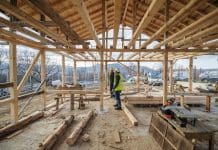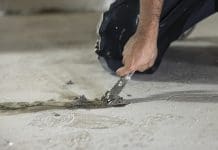Structural waterproofing is vital for underground projects. Here’s what you should focus on, says Steve Hodgson, Chief Executive, Property Care Association
By freeing up underground space – either through new build projects or refurbishment works – homes can be transformed, creating flexible living opportunities which make the most of the land available underfoot.
However, such works can be particularly sensitive to failures due to poor workmanship or the inappropriate use of materials or bad design.
National trade body the Property Care Association (PCA) offers a raft of support and initiatives to drive best practice in the structural waterproofing industry – including assisting the NHBC in the development of Chapter 5.4, their revised construction standard for waterproofing basements and other below ground structures.
This new section, launched in 2014, was produced in response to an NHBC report published in 2013, which revealed claims on basements since 2005 had cost the industry a total of nearly £21 million – and affected nearly 890 homes.
Knowing A B and C
There are three forms of structural waterproofing, Type A, B and C. Type A is usually referred to as ‘tanked protection.’ These are structures that have no integral protection against water penetration and rely totally on a waterproofing membrane to keep water out.
Type A forms of waterproofing may be applied internally or to the outside of the structure or, in some cases, sandwiched between two skins of masonry or concrete.
Structures built with a water resistant shell are referred to as Type B waterproofing systems. These will usually be constructed out of reinforced concrete to an appropriate design code, which gives guidance in the grade of concrete to be used and spacing of the reinforcing steel. Special additives may also be used.
Type C or ‘drained cavity’ systems rely on a drained cavity within the basement structure. There is a permanent reliance on the cavity to collect groundwater that enters through the fabric of the structure. The drainage system directs the water to a drain or sump, where it can be removed from the building by gravity or pumping.
Grades and Groundworks
As well as consideration of the types of waterproofing regarding A B and C, basements are also graded numerically depending on their specification.
There are three grades of basement environment, 1, 2 and 3. Examples of a grade 1 environment include a car park and plant room without electrical equipment, where it’s considered tolerable to have some seepage and damp areas appropriate to the intended use.
No water penetration is acceptable for a grade 2 environment. Damp areas are tolerable, and ventilation might be required.
For grade 3, no water penetration is acceptable, and this performance level also specifies ventilation, dehumidification or air conditioning as necessary appropriate to the intended use.
Understanding these grades and ensuring the necessary features are introduced to meet the grades is critical from the start of the project.
Another factor which should be carefully considered in the early stage is the groundworks. Factors such as the type of soil and the water table are just some of the issues which need to be kept in mind.
Future Proofing
Structures evolve and change their use. This should be another element considered at the start of the project when looking into ventilation and thought out both regarding current proposed use and with the future in mind.
For example, if the structure is going to be a garage which might eventually become a bedroom, then ventilation should be considered specifically for the more advanced requirement of the future at the construction stage, not left for a later date.
Another thought for the years ahead is the ability to care for and maintain the structure.
Therefore, it’s important that consideration is given towards remedial works to enable a feasible repair to be carried out to the waterproofing should it be required in the future.
To ensure this is possible, maintenance features should be built in from the start.
Workmanship matters
The best materials in the world are only as good as the people that install them.
The construction teams applying, installing and building the underground space must be fully aware of the critical nature of what they are doing, the importance of accuracy and the implications of any defects and errors.
With this in mind, structural waterproofing projects should be undertaken by experts who understand the industry. To support this, the PCA provides a searchable register of Waterproofing Design Specialists — a pool of vetted and approved professionals with specialist knowledge and qualifications in structural waterproofing who can assist in the design and planning of projects involving underground waterproofing in accordance with BS8102.
This register, available to view at http://www.property-care.org/ProGuidance.RWDS.asp gives architects and construction professionals details of individual, competent practitioners, who can assist in the design and planning of underground waterproofing.
Supporting the industry
The Property Care Association offers a comprehensive training programme in line with its mission to promote technical competence in the industry. At the core of this programme is the three-day Surveyor in Structural Waterproofing training course — an intensive theoretical training course for those involved in converting existing basements and structural waterproofing projects below ground.
The training can also be used as foundation study for those studying for the formal Certificated Surveyor in Structural Waterproofing (CSSW) qualification.
There’s also a new suite of training courses, introduced last year, which enable construction professionals to broaden their knowledge of the subject. Among these new programmes is the Basement Water Management course, developed for construction and surveying professionals looking to gain a better understanding of the theory and practical application of pump stations and accessories relating to Type C cavity membrane systems.
The Structural Implications of Waterproofing course has also been introduced – which aligns the activities of waterproofing surveyors and system designers with the relevant elements studied by structural and civil engineers, including applied mechanics, the theory of structures and hydraulics.
Full details of each course and a calendar of training dates are available to view at http://www.property-care.org/training-qualifications/
Other initiatives
The PCA offers free access to a series of best practice guides, overseen by the PCA’s Structural Waterproofing Group (and some partly funded by the CITB).
These cover Type A, Type B and Type C waterproofing systems and are available at http://bit.ly/1KIWTTd
The Association is also holding an annual structural waterproofing conference to help professionals stay up-to-date, with the 2017 event scheduled for 6th July in Coventry. More details and booking details are on the PCA website.
Steve Hodgson
Chief Executive
Property Care Association
pca@property-care.org
















